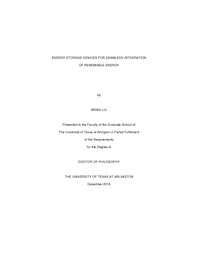
ATTENTION: The works hosted here are being migrated to a new repository that will consolidate resources, improve discoverability, and better show UTA's research impact on the global community. We will update authors as the migration progresses. Please see MavMatrix for more information.
Show simple item record
| dc.contributor.author | Liu, Meng | en_US |
| dc.date.accessioned | 2015-07-01T17:50:16Z | |
| dc.date.available | 2015-07-01T17:50:16Z | |
| dc.date.issued | 2014-12 | |
| dc.date.submitted | January 2014 | en_US |
| dc.identifier.other | DISS-12849 | en_US |
| dc.identifier.uri | http://hdl.handle.net/10106/24894 | |
| dc.description.abstract | Renewable energy, as a promising resource for supporting continuously growing electricity demand, bears the disadvantages of un-controllable variability and partial unpredictability, which present challenges for large-scale integration into power systems. To maintain stable system frequency, the mechanical energy driving the generators should be balanced with the electrical energy consumed by loads and losses at all times. However, high penetration level of renewable energy presents challenges for this basic requirement. Energy storage system (ESS) is one of the most promising solutions to shape the variable renewable generation to follow certain production plans which benefits both system operation and market participation. In addition, ESS can contribute to grid reliability needs, defer transmission and distribution upgrade investments as well as integrate renewable generation resources. Currently, it requires significant financial commitment for the implementation of large-scale ESS. Therefore, designing efficient ESS and developing effective operation algorithms for seamless integration of renewable energy are of great importance. The Electrical Reliability Council of Texas (ERCOT) launched a nodal market in December, 2010, aiming at improving grid reliability, increasing market efficiency, and enabling transparency of wholesale energy prices. Under the new market design, the grid congestion and the Locational Marginal Price (LMP) will be captured more rapid and granular across the network. LMP is defined as the "marginal cost of supplying, at least cost, the next increment of electric demand at a specific location on the electric power network, taking into account both supply bids and demand offers and the physical aspects of the transmission system including transmission and other operation constraints". The variations of LMP across the network and the variations of LMP at any specific node along a day provide market participants more opportunities to pursue financial benefits. Moreover, participating energy efficiency programs like demand response (DR) program may bring market participants extra revenue. Texas Legislature passed Senate Bill (SB) 1125 in 2011, and one purpose of SB1125 is to qualify residential and commercial customer classes for participation in DR programs.Considering the market opportunities for renewable energy, ESS is the key to reshape the random output dominated by weather condition to follow certain desired pattern. ESS can also work as the bridge between convenience and revenue when participating in demand response programs. This dissertation presents the efforts involved in developing ESS operating strategies for different market participants, including renewable energy generation and end-user customers DR participation on both residential level and aggregated level. For renewable generation side, this dissertation addresses the idea of developing wind and solar PV hybrid system using ESS to compensate the intermittent output and match system load profile considering the facts that wind power has higher output at late night and early morning while solar PV only generates during day time. A hybrid ESS is also designed to dispatch wind farm output for maximizing financial revenue based on wind and LMP forecasting using Artificial Neural Networks (ANN). For end-user customer side, different scenarios are designed and studied for demand response program participation. Residential appliances are classified and controlled accordingly to take advantage of the LMP information. Thus, ESS is utilized to integrate renewable energy at distribution level so that under different operation schemes, significant financial revenue can be collected and system reliability can be maintained. | en_US |
| dc.description.sponsorship | Lee, Wei-Jen | en_US |
| dc.language.iso | en | en_US |
| dc.publisher | Electrical Engineering | en_US |
| dc.title | Energy Storage Devices For Seamless Integration Of Renewable Energy | en_US |
| dc.type | Ph.D. | en_US |
| dc.contributor.committeeChair | Lee, Wei-Jen | en_US |
| dc.degree.department | Electrical Engineering | en_US |
| dc.degree.discipline | Electrical Engineering | en_US |
| dc.degree.grantor | University of Texas at Arlington | en_US |
| dc.degree.level | doctoral | en_US |
| dc.degree.name | Ph.D. | en_US |
Files in this item
- Name:
- Liu_uta_2502D_12849.pdf
- Size:
- 1.845Mb
- Format:
- PDF
This item appears in the following Collection(s)
Show simple item record


